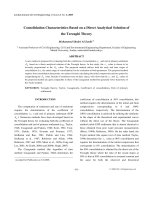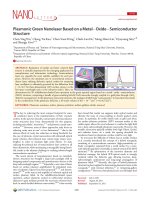Consolidation Chareteristics based on a direct analytical solution of the Terzaghi Theory
Bạn đang xem bản rút gọn của tài liệu. Xem và tải ngay bản đầy đủ của tài liệu tại đây (138.99 KB, 9 trang )
Jordan Journal of Civil Engineering, Volume 2, No. 2, 2008
- 91 -
Consolidation Characteristics Based on a Direct Analytical Solution of
the Terzaghi Theory
Mohammed Shukri Al-Zoubi
1)
1)
Assistant Professor of Civil Engineering, Civil and Environmental Engineering Department, Faculty of Engineering,
Mutah University, Jordan,
ABSTRACT
A new method is proposed for evaluating both the coefficient of consolidation
v
c
and end of primary settlement
p
δ
based on a direct analytical solution of the Terzaghi theory. In this study, the
v
c
value is shown to be
inversely proportional to the
p
δ
value. The proposed method utilizes both the early and later stages of
consolidation (i.e., the entire range of consolidation) for the evaluation of both parameters. The proposed method
requires four consolidation data points; two points for back-calculating the initial compression and two points for
extrapolating the
p
δ
value. Results of oedometer tests on three clayey soils show that the
v
c
and
p
δ
values of
the proposed method are quite comparable to those of the Casagrande method but generally lower than those of
the Taylor method.
KEYWORDS: Terzaghi theory, Taylor, Casagrande, Coefficient of consolidation, End of primary
settlement.
INTRODUCTION
The computation of settlement and rate of settlement
requires the determination of the coefficient of
consolidation (
v
c
) and end of primary settlement (EOP
p
δ
). Numerous methods have been developed based on
the Terzaghi theory for evaluating both the coefficient of
consolidation and end of primary settlement (e.g., Taylor,
1948; Casagrande and Fadum, 1940; Scott, 1961; Cour,
1971; Parkin, 1978; Sivaram and Swamee, 1977;
Sridharan and Rao, 1981; Parkin and Lun, 1984;
Sridharan et al., 1987; Robinson and Allam, 1996;
Robinson, 1997 and 1999; Mesri et al., 1999a; Feng and
Lee, 2001; Al-Zoubi, 2004a and 2004b; Singh, 2007).
The Casagrande method (the logarithm of time
method; Casagrande and Fadum, 1940) determines the
coefficient of consolidation at 50% consolidation; this
method requires the determination of the initial and final
compressions corresponding to 0 and 100%
consolidation, respectively. The determination of the
100% consolidation is achieved by utilizing the similarity
in the shape of the theoretical and experimental curves
without the direct use of the theory. The Casagrande
method yields EOP settlement that is almost identical to
those obtained from pore water pressure measurements
(Mesri, 1999b; Robinson, 1999). On the other hand, the
Taylor method (the square root of time method; Taylor,
1948) determines the
v
c
value at 90% consolidation and
requires the determination of the initial compression that
corresponds to 0% consolidation. The determination of
the 90% consolidation is obtained by the direct use of the
Terzaghi theory where the ratio of the secant slopes at
50% to that at 90% consolidation is assumed constant and
the same for both the observed and theoretical
Accepted for Publication on 1/4/2008.
© 2008 JUST. All Rights Reserved.
Consolidation Characteristics
…
Mohammed Shukri Al-Zoubi
- 92 -
compression – square of time relationships as will be
shown later in this paper. Both the Casagrande and
Taylor methods utilize the same theoretical basis for
evaluating the initial dial gauge reading that corresponds
to 0% consolidation (Al-Zoubi, 2004a), but these two
methods differ in the way the end of primary
consolidation is identified. The Taylor method generally
yields lower
p
δ
values and higher
v
c
values as
compared to the Casagrande method.
In general, different values for the coefficient of
consolidation and/or the end of primary consolidation
have been obtained using the various existing methods
developed based on the Terzaghi theory that assumes
constant coefficient of consolidation. These differences in
p
δ
and
v
c
values obtained from these methods for a
particular pressure increment may be attributed to one or
more of the following factors: (a) variations in
v
c
that
may increase, decrease or remain constant during a
pressure increment (Al-Zoubi, 2004a and b), (b)
resistance of a clay structure to compression (Mesri et al.,
1994), (c) recompression-compression effects due to
spanning preconsolidation pressure
p
'
σ
(Mesri et al.,
1994), (d) duration of pressure increment including
secondary compression (Murakami, 1977); long duration
of pressure increments may produce recompression-
compression effects similar to those of preloading (Mesri
et al., 1994), (e) procedure adopted to obtain
p
δ
(the
range of primary consolidation or part of this range or at
least a point within this range must be matched with the
Terzaghi theory to be able to estimate the coefficient of
consolidation) and (f) the existing methods may involve
additional assumptions to those of the Terzaghi theory.
In this paper, a new method is proposed in order to
improve the estimation of the end of primary settlement
(
p
δ
) and the coefficient of consolidation (
v
c
). The
proposed method is compared to the Taylor and
Casagrande methods utilizing results of oedometer tests
on three clayey soils. The basic properties of these three
soils are given in Table 1. As can be seen from Table 1,
the soils utilized in the present study cover a relatively
wide range of liquid limit and plasticity characteristics;
the liquid limit for these soils ranges from 29% to 108%
and the plasticity index ranges from 12% to 66%.
THE PROPOSED METHOD
The actual theoretical one-dimensional consolidation
relationship between average degree of consolidation
U
and the time factor
T
obtained from the Terzaghi theory
may, depending on the range of
U
, be given by the
following two expressions (Terzaghi, 1943; Olson, 1986):
For
6.52≤
U
%
TU
π
4
=
(1)
For
6.52≥U
%
()
TLnULn
4
8
1
2
2
π
π
−=−
(2)
In the Terzaghi theory, the consolidation time
t
is
defined in terms of time factor
T
, maximum drainage
path
m
H
and coefficient of consolidation
v
c
as follows:
v
m
c
HT
t
2
=
(3)
On the other hand, the settlement
t
δ
may be
expressed in terms of the average degree of consolidation
U
and EOP settlement
p
δ
by the following expression:
pt
U
δδ
=
(4)
where
opp
dd −=
δ
;
p
d
is the dial reading at the
end of primary consolidation and
t
δ
is the settlement at
time
t
during consolidation and is equal to
ot
dd
−
;
t
d
is the dial reading at time
t
and
o
d
is the dial reading
corresponding to 0% consolidation, which may be given
as follows (e.g., Al-Zoubi, 2004a):
12
1212
/1
/
tt
ttdd
d
tt
o
−
−
= (5)
Jordan Journal of Civil Engineering, Volume 2, No. 2, 2008
- 93 -
where
1
t
d
and
2
t
d
are the dial gauge readings at time
1
t
and time
2
t
, respectively, and are selected such that
these two points are on the initial linear portion of the
td
t
−
curve. This is the same basis utilized by the
Casagrande and Taylor methods since the three methods
utilize the same equation (Eq. 1) for obtaining the initial
compression
o
d
. Hence, the Taylor and Casagrande
methods are similarly affected by the factors that
influence the initial portion of the consolidation curve.
Table 1: The basic properties of the three soils utilized in the present study.
Particle size
Soil
Sand
(%)
Silt
(%)
Clay
(%)
Liquid
Limit
(%)
Plastic
Limit
(%)
Specific
Gravity
Azraq Green Clay (AGC) 8 23 69 108 42 2.76
Chicago Blue Clay (CBC)* 4 64 32 29 17 2.73
Madaba Clay (MDC) 14 41 45 55 25 2.78
* These basic properties for the Chicago Blue Clay were obtained by the Author; whereas the
consolidation data were obtained from Taylor (1948).
Table 2: Results of the proposed method using consolidation data obtained from Taylor (1948), page 248.
Time (min) 0 0.25 1 2.25 4 6.25 9 12.25 16
Dial Reading
(x 10
-4
in)
1 in = 25.4 mm
1500 1451 1408 1354 1304 1248 1197 1143 1093
average
COV
(*)
(%)
m
(mm /min
-1/2
)
(between any two
consecutive points)
----- ----- ----- 0.274 0.254 0.284 0.259 0.274 ----- 0.269 4.55
0
d
(25.4 x 10
-4
mm)
----- ----- ----- 1516 1504 1528 1503 1521 ----- 1514 0.72
Time (min) 20.25 25 30.25 36 42.25 60 100 200 400 1440
Dial Reading
(x 10
-4
in)
1 in = 25.4 mm
1043 999 956 922 892 830 765 722 693 642
settlement
ti
δ
1.201 1.313 1.422 1.509 1.585 1.742 1.908 2.017 2.090 2.220
EOP
pi
δ
1.674 1.717 1.780 1.791 1.806 1.864 1.911 2.018 2.092 2.220
Coefficient of
consolidation
2
/
mv
Hc
(10
-3
min
-1
)
21.1 20.1 18.7 18.4 18.1 17.0 16.2 ----- ----- -----
(*)
COV
is the coefficient of variation.
Consolidation Characteristics
…
Mohammed Shukri Al-Zoubi
- 94 -
Table 3: Comparison of
p
δ
and
v
c
values of the Proposed, Taylor and
Casagrande methods using the consolidation data of Table 2.
Method
EOP settlement
p
δ
(mm)
2
/
mv
Hc
(x 10
-3
min
-1
)
Taylor 1.846 17.4
Casagrande 1.927 15.9
Proposed
(this study)
1.921 16.0
However, these methods differ in the way by which the
primary consolidation range (or EOP
p
δ
) is obtained as
shown later.
Based on Eqs. 1, 3 and 4, the coefficient of
consolidation may be given by the following expression
(Al-Zoubi, 2004a):
2
4
⎟
⎟
⎠
⎞
⎜
⎜
⎝
⎛
=
p
m
v
Hm
c
δ
π
(6)
where
m
is the slope of the initial linear portion of
the observed
t
t
−
δ
curve that may be computed as
follows:
12
12
12
12
tt
dd
tt
m
tttt
−
−
=
−
−
=
δδ
(7)
Equation 6 shows that the
v
c
value is dependent on
both the value of the slope
m
as well as that of the end of
primary settlement
p
δ
. Equation 6 shows also that the
coefficient of consolidation can not be obtained from
only the initial portion because Eq. 6 involves three
unknown values (i.e.,
0
d
,
p
d
and
m
; where
0
dd
pp
−=
δ
). Therefore, the value of
p
d
must be
determined from the later stages of consolidation
(theoretically, from the range of
6.52
≥U
%) while both
0
d
and
m
can be obtained from the initial portion of the
t
t
−
δ
curve. At least one additional data point (
ti
d
,
i
t
)
must be selected from the consolidation data for
estimating the end of primary settlement
p
δ
in addition
to the two data points (
1t
d
,
1
t
) and (
2t
d
,
2
t
) required for
obtaining the initial compression
0
d
using Eq. 5 and the
slope
m
of the initial linear portion of the observed
t
t
−
δ
curve using Eq. 7.
A theoretical expression for estimating the EOP
settlement
p
δ
may be obtained by combining Eqs. 2
through 6 as follows:
()()
0938.1,,
2
2
=+−−=
i
p
ptipitip
t
m
LnLntf
δ
δδδδδ
(8)
where
0
dd
titi
−=
δ
is the settlement at time
i
t
and
0
dd
pp
−=
δ
.
In order to solve Eq. 8 for
p
δ
, three data points {i.e.,
(
1t
d
,
1
t
), (
2t
d
,
2
t
) and (
ti
d
,
i
t
)} must be selected from
the consolidation data. The first two data points (
1t
d
,
1
t
)
and (
2t
d
,
2
t
) are required for obtaining the initial
compression
0
d
and the slope
m
as described above.
The third data point (
ti
d
,
i
t
) can be taken at any time
beyond the initial linear portion (i.e., the subscript
i
refers to any data point in the range of
6.52≥U
%).
The solution of Eq. 8 using the selected three data
points requires iterations for obtaining the EOP
settlement
p
δ
(and then obtaining the coefficient of
consolidation
v
c
using Eq. 6). However, this solution can
be obtained graphically or numerically by using any
method for finding the roots of an equation. The ©
Microsoft Excel Solver was, however, utilized in this
study for solving Eq. 8.
Jordan Journal of Civil Engineering, Volume 2, No. 2, 2008
- 95 -
δ
p
, x10
-4
in. (1 in. =25.4 mm)
600 700 800 900 1000
f(
δ
p
)
-0.2
-0.1
0.0
0.1
0.2
Set1: Points 1, 2, 4
Set2: Points 1, 2, 3
Data from Taylor (1948)
δ
p4
= 1.791 mm
Point time Dial Reading
No. (min) (25.4 x 10
-4
mm)
(1) 1.00 1408
(2) 2.25 1354
(3) 20.25 1042
(4) 36.00 922
2
4
⎟
⎟
⎠
⎞
⎜
⎜
⎝
⎛
=
p
m
v
Hm
c
δ
π
δ
p3
= 1.674 mm
Figure (1): Graphical solution of Eq. 8 using two sets of selected data points.
δ
ti
, mm
0.0 0.5 1.0 1.5 2.0 2.5
δ
pi
, mm
0.0
0.5
1.0
1.5
2.0
2.5
Solution of Eq. 8 where the
third point was selected
at different times
a
= 1.2760
b
= 0.3359
r
2
= 0.9954
δ
p
i
=
δ
t
i
δ
p
i
=
a
+
b
δ
t
i
b
a
p
−
=
1
δ
primary
consolidation
secondary
compression
δ
50
From
Fig. 1
δ
p
=
1.921 mm
Figure (2):
Estimates of EOP settlement
pi
δ
obtained from the analytical solution using
Eq. 8 a function of
ti
δ
.








